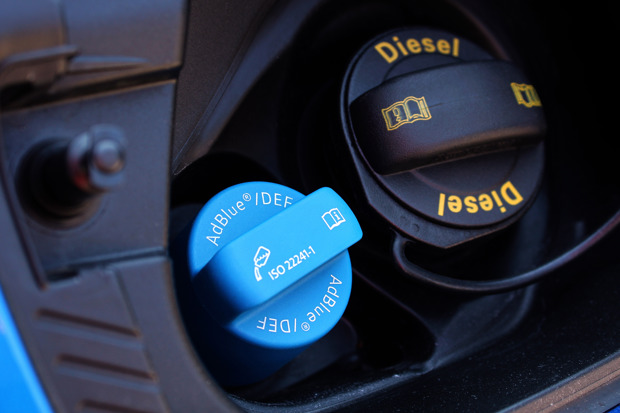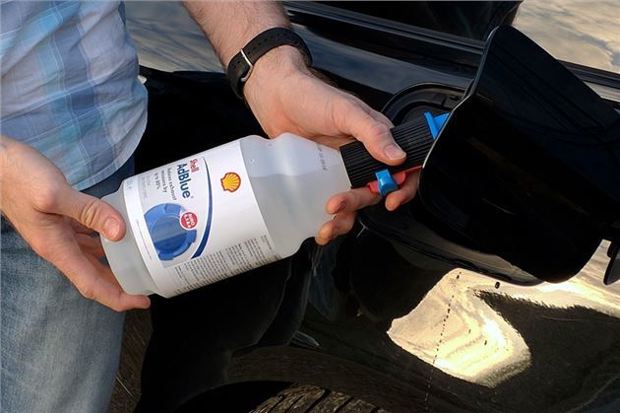What is AdBlue? Your complete guide
If you've seen bottles of AdBlue at filling stations and wonder what it's for and whether your car needs it, our guide will tell you everything you need to know.

- What does AdBlue do?
- Does your car need AdBlue?
- How much does AdBlue cost?
Picture the scene: you're in the queue to pay at the filling station, your eyes are drawn to all manner of treats and gadgets you don't need, so to avoid the distractions you look downward only to spot the person in front is holding a 10-litre bottle of something called AdBlue... what on earth is that?
The chances are, if you don't know what AdBlue is you — or more specifically, your car — won't need it.
Newer diesel engines are fitted with equipment that converts harmful exhaust emissions into ones that casuse no damage.
For that to happen, the process requires a urea- and water-based liquid to be used, in this case Diesel Exhaust Fluid (DEF).
Strictly speaking, although DEF is the generic name for this non-toxic fluid, it's more commonly known by its German Association of the Automotive Industry trade name — AdBlue.
What does AdBlue do?
Okay, here comes the science bit.
Most Euro6-compliant diesels — and many Euro5 level ones — are fitted with a Selective Catalytic Reduction (SCR) system that converts harmful gases into safer ones.
In order for this chemical change to occur, miniscule doses of a reductant — that'll be the AdBlue — are sprayed into the exhaust gas flow as it enters the catalytic convertor. At this point, thanks to the high temperatures involved, the AdBlue turns into ammonia and carbon dioxide.
The ammonia reacts with the nitrogen oxides (NOx) converting them into diatomic nitrogen and water, neither of which are harmful.
None of this produces any noticeable effect on how the car drives or how you operate it. The AdBlue is metered-out automatically as you drive, requiring no additional input, save for when the tank requires refilling.
Which cars use AdBlue?
Only diesel-engined cars have the potential to require AdBlue and for the most part, these will be under ten years old. However, some of the earliest cars sold here with SCR systems will be a little older than that.
Even with diesel cars fitted with SCR systems, it's not always obvious that they are present, so it's best to check your vehicle's handbook to know for sure.
Some giveaways you may have spotted are a light blue cap for the AdBlue tank, which may be positioned next to the regular black diesel one, or a warning message on your car's instrument display advising you that the tank needs refilling — there's no permanent gauge to constantly show how much is in there.
Many manufacturers, but not all, gave their earlier AdBlue diesels different marketing names, but these weren't consistently applied and now that it's commonplace, most no longer bother. These names include:
- BMW — BluePerformance
- Citroen — BlueHDi
- Dacia — Blue dCi
- DS — BlueHDi
- Ford — EcoBlue
- Hyundai — Blue Drive
- Mercedes — BlueTEC
- Peugeot — BlueHDi
- Renault — Blue dCi
- Vauxhall — BlueInjection
- Volkswagen — BlueMotion

How do I know if my AdBlue tank needs refilling?
AdBlue is a relatively recent addition to newer diesel-engined cars, the information display on your instrument panel will alert you when the tank's running low rather than having a dedicated dial showing you the level.
As it is a critical system with regards to the running of the car, it will start to warn you with plenty of notice, usually when there's still more than 1000 miles of range in the tank. Don't be tempted to let it go down to empty because there are significant consequences for doing so.
Due to AdBlue being required to reduce the exhaust emissions, if the tank is empty the car won't legally comply with the regulations. In order to prevent this from happening, manufacturers have installed a couple of failsafes.
Should you run out of AdBlue while driving, the engine will switch to a state called limp mode. This is when the car's Engine Control Unit (ECU) reduces power and can even lock out some higher gears in automatic transmissions, so you have to trundle along at very low speeds until you turn it off.
That second failsafe ensures that when the AdBlue tank is empty, the car won't start at all.
Can I refill the AdBlue tank myself?
In most cases this is entirely possible but on some cars the position of the tank opening — and the way you're refilling it — may discourage you from doing so.
While the vast majority of AdBlue-equipped cars have a filler cap for the tank next to the one where you refill your diesel, some cars have theirs positioned under the bonnet or even beneath the floor of the boot.
Although AdBlue is non-toxic and non-flammable, it's advised to wear gloves while refilling the tank and avoid spilling any on boot carpets and clothing. It isn't likely to stain fabric surfaces, but it dries with to a white, crystalised finish that seems to take forever to vacuum off.
While smaller bottles of AdBlue usually come with a convenient narrow nozzle to help minimise spillage, the larger ones, typically of a 10-litre capacity don't. An awkwardly positioned tank opening and a large, difficult to position bottle are not a great combination, as you'll doubtless discover as it glugs out all over the place.
It's worth hunting-out filling stations that have a dedicated AdBlue pump dispenser, although such facilities are far from the norm. They can often be found at sites where trucks can refuel, although these tend to flow much faster than ones designed for cars, increasing the spillage risk.
It's also worth noting that AdBlue has a shelf-life of 12 months, so don't be tempted to stockpile bottles of it if you're a low-mileage driver. Once it's past its use-by date, the car's sensors will note it's not up to scratch and you may be stuck in limp mode.
How much AdBlue will my car use?
Just as different cars will sip their diesel at different rates, the same is true of AdBlue consumption — the gentler you drive, the longer it will last.
Unlike diesel consumption, car manufacturers are not legally required to publish standardised test results illustrating the rate of AdBlue use.
In broad terms, though, most cars will typically cover 500-750 miles for each litre of AdBlue available.
Typically, AdBlue tanks have capacities of more than 10 litres, but rarely over 20 litres, so you may find you never need to refill it yourself as it will get done as part of your annual service.
How much does AdBlue cost?
Inevitably it is cheaper to buy AdBlue from an online retailer or car accessory store than from a dealership, so shop around if you have the choice.
Online, AdBlue can be bought for the equivalent of £1.20 per litre, so don't be tempted into paying much more for it.
If you don't fancy tackling refilling it yourself, Halfords* offers a top-up service, including the AdBlue itself, for £27.99.
